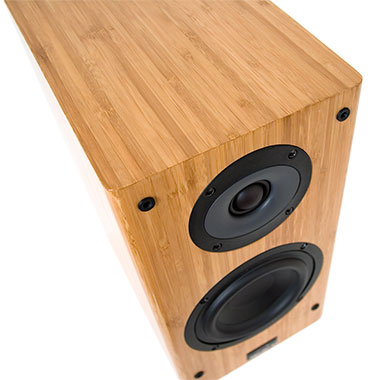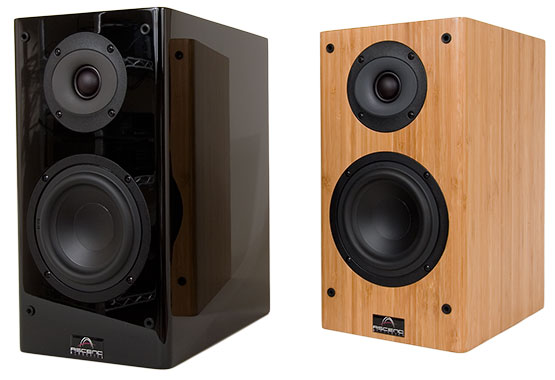Perhaps the most unique feature of the Sierra is the cabinet.
While fiber board (MDF and HDF) is generally a good material for a loudspeaker cabinet, it is far from ideal. It is used because it is easy to cut, extremely affordable and it does an adequate job at minimizing resonance and isolating the back wave response and various mechanical noises produced by the drivers. Many high-end manufacturers have gone to extremes to improve cabinet materials, using advanced ceramics, extruded aluminum, epoxies, stone; all in the goal of reducing cabinet resonance and improving sound isolation. The results of these improvements can be dramatic at times, greatly improving accuracy, transparency and imaging.
The simplest and most cost-effective method to improve the function of the cabinet would be to use very thick MDF. We made an investment in setting up a dedicated measurement system specifically designed to test various cabinet materials. This in itself was a difficult task as it required quite a bit of research, requiring very specific electronics and various modifications in order to get everything to function together - accelerometers, multiplex controllers and a DSP based MLS system. I am pleased to say that we have now added this capability to our already impressive engineering facility.
Various testing confirmed my suspicions. I took measurements using 5/8", ¾", 1", 1.5" even 2" thick MDF sample cabinets. Obviously, the thicker the cabinet, the less measurable resonance but the reduction in resonance is what surprised me most. The cabinet with 2" walls was only marginally improved over ¾" walls, thus confirming why select manufacturers use materials other than MDF for their top performing products. MDF is adequate, inexpensive and convenient but I desired something that would result in a significant reduction to cabinet resonance and improve isolation without having to use 3" thick baffles. This was quite a challenge because I had already defined the external dimensions of the loudspeaker.
Perhaps it was fate or just blind luck but I was introduced to a wonderful piece of furniture about 3 years ago. This was a dining room table - an expensive, beautifully crafted unique piece of art that was stronger than any piece of furniture I had ever examined before. The manufacturer of this table approached me and explained that this was made from vertically laminated bamboo. Hundreds of solid bamboo panels, each about ¼" thick laminated together.
After a brief discussion with this custom furniture manufacturer (experts in the use of bamboo), they decided to build me a prototype cabinet for the Sierra made of the same material as the table. A few weeks later I had the sample in hand. The first thing I noticed was how rigid the cabinet felt. It is difficult to describe but after handling tens of thousands of loudspeaker cabinets, you get a feel when something is different. Second thing I noticed was that my production crew was not able to install the wood screws into the pilot holes using our normal torque settings. I was shocked at how difficult it was to actually install the wood screws to hold the various components, this material was incredibly strong.
My jaw dropped when I took accelerometer measurements of the cabinet. I could not believe what I saw, this cabinet showed DRAMATIC reductions in resonance, even when compared to the same cabinet made with 1.5” MDF. We found our cabinet material, finding a vendor to actually build these for us was another story…
The problem we found with laminated bamboo, besides being expensive, is that it is so incredibly tough that typical router bits used in CNC routers are not adequate. While they cut through MDF like a warm knife though butter, they would quickly dull and would not cut cleanly through the bamboo. After much frustration, we found a high-end OEM loudspeaker cabinet factory that was willing to use the highest grade router bits available (and constantly replace them). Of course, the cost of this type of cutting would ultimately fall on our shoulders but at least we found a company willing to undertake the project. This was "uncharted" territory for both us and them.
Years later, together with the cooperation of one of the worlds foremost authorities of bamboo products, we feel we have optimized the process to a point where we can now manufacture laminated bamboo loudspeaker cabinets at decent volume levels and keep costs reasonable. I am so pleased about this on many different levels, it is a truly magical material that offers unmatched performance and beauty and is truly an earth-friendly renewable resource.
While century old trees are being cut down in the great rain-forests of South America and Africa, here is a product that offers natural beauty while offering proven performance improvements without the dramatic and permanent hit to our fragile ecosystem. The loudspeaker industry's affect on our natural resources is one of those unspoken evils. Ascend Acoustics is proud to say that not a single tree is destroyed for the production of the Sierra and we hope we can continue this trend.
About the Sierra cabinet:
The cabinet is made from vertically oriented laminated bamboo paneling. We call it V-LAM™ for short. There are over 200 individual sheets of ¼" thick bamboo, each laminated to another using environmentally friendly epoxies and arranged such that each panel is vertical (imagine a row of ¼" thick books placed on a bookshelf) forming a baffle that is 3/4" thick. The cabinet is extremely rigid and tough. I have had a cabinet sitting outdoors for nearly 2 years, fully exposed to all the extremes of Southern California weather; intense sunlight, strong winds, rain and even some cold. The integrity of the cabinet has not been compromised in any way.
The inside walls are lined with top-grade damping material and each joint is well braced. We custom tooled a high-flow flared port tube which is flush mounted into the rear of the cabinet. All drivers are flush mounted to reduce baffle reflections and the front baffle vertical edges have a beautiful radius which aids in the reduction of diffraction.
The build and finish quality of the Sierra is unmatched. There is no veneer or wrap of any kind so there is no concern about peeling or cracking. We apply a semi-gloss lacquer to the natural wood to give some added sheen and enhance the natural beauty.
For those who don't desire the natural finish, we offer a stunning piano black finish. This was a difficult process since the bamboo we are using is non-porous (as compared to MDF) so a new finishing technique had to be developed. The results of which are just incredible, the finest piano black finish I have ever seen! True mirror quality.
Some info about Bamboo:
- Bamboo is an environmentally friendly, renewable resource that has been used as construction material for thousands of years. Ecologically, the harvesting of bamboo does not affect the world's dwindling timber resources. Technically considered a grass, bamboo has the ability to grow to maturity in only 3-6 years. The intricate root system remains unharmed upon harvesting and allows for sustainable future growth.
- It is incredibly strong and considered one of the most durable hardwoods. It has a tensile strength that is stronger than steel and the vertical orientation of the panels we use take full advantage of this.
- The bamboo we use is completely moisture resistant. MDF will swell when exposed to moisture and this is often the cause for the cracking and peeling of the various finishes applied to MDF loudspeakers over a period of time.
- Our bamboo is safe for factory workers and for you. MDF is a health hazard for anyone cutting or sanding it, so much so that places like Lowes and Home Depot will refuse to cut it for you.
A summary of features of the cabinet:
- Exclusive V-LAM™ construction, cabinet is made from vertically laminated solid bamboo panels which provide extreme rigidity and less energy loss, dramatically reducing cabinet resonance while improving bass performance, accuracy and transparency.
- Environmentally friendly and free of toxins commonly found in MDF cabinets.
- Top-grade internal damping materials uses on all internal walls.
- All joints are well braced.
- All drivers are flush mounted to reduce reflections
- Available in natural or piano black finishes
- Top-grade 5-way gold plated binding posts.
Now for some cabinet measurements:
Measurements taken using an accelerometer attached to the middle of the side baffle. 7.5v bandwidth limited (2kHz) pink-filtered source signal. Speaker A is the Sierra, speaker B is a very highly regarded 2 way bookshelf speaker with 1" MDF baffles. The speakers are similar in size. Please note: Speaker B is considerably more expensive.
Impulse Response
Green = Sierra, Blue = Competitor
Spectral Decay, Sierra
Spectral Decay, Competitor, 1" MDF cabinet
You are seeing not only a significant reduction in resonance but also considerably faster recovery from various resonance modes; with the end result being less cabinet effects for greater accuracy, clarity and transparency.
And finally.. a few more pics


 |














